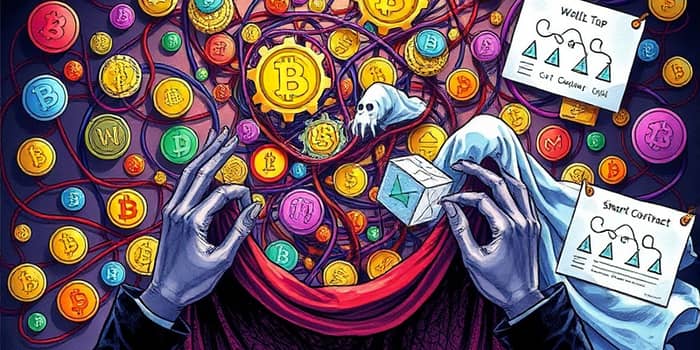
In the fast-paced world of decentralized finance, vigilance is your most powerful ally. Rug pulls can wipe out your investments in an instant, leaving behind shattered hopes and empty wallets. By learning the key red flags and adopting proactive risk assessment practices, you can protect your assets and navigate the crypto landscape with confidence.
Understanding how to spot fraudulent schemes early not only safeguards your funds but also contributes to a healthier, more transparent ecosystem. This article will guide you through the mechanisms of rug pulls, the warning signs you can’t afford to ignore, and the steps you can take to fortify your investments against emerging threats.
A rug pull is a malicious act where project developers seize investor funds and disappear, rendering tokens worthless. These scams exploit the low barriers to launching new tokens on platforms like Ethereum and Binance Smart Chain, where a few lines of code can create a fully tradable digital asset.
In 2021, rug pulls accounted for an astonishing 37% of all crypto scam revenue, stealing over $2.8 billion in value. By Q3 2023, they represented 65% of recorded crypto attacks, with nearly $50 million lost in a single quarter. Such staggering figures illustrate how predators can pounce on even the smallest communities.
Consider the story of Alex, a passionate crypto enthusiast who invested his entire digital savings into a promising new token. Within days of its launch, the project’s developers withdrew the liquidity, causing the token price to collapse. Alex watched helplessly as his balance plummeted to zero, highlighting the devastating emotional toll these scams can inflict.
Rug pulls manifest in many forms: liquidity withdrawals, token minting, coordinated pump-and-dumps, and more subtle team exits. Regardless of the tactic, they share a common thread—developers manipulate code or market forces to drain funds and vanish without trace.
High-impact liquidity rug pulls occur when developers drain the liquidity pool, making it impossible to sell tokens. Investors are left holding worthless assets while the price collapses in seconds.
Minting rug pulls involve hidden token minting functions that allow extra tokens to be created at will. These tokens are sold on the market, flooding supply and destroying value for genuine holders.
Fake projects lure investors with flashy marketing with no substance. Once sufficient funds are raised, the team vanishes, delivering nothing but an empty GitHub repository.
Pump-and-dump scams rely on large-scale coordinated pump-and-dump schemes to inflate a token’s price artificially. Early insiders sell at the peak, triggering mass sell-offs and dramatic price crashes.
Team exit, or soft rug pulls, are more subtle. Developers execute gradual developer token sell-offs, quietly eroding value while maintaining a facade of legitimacy.
These indicators, when combined, create a powerful early warning system. If you encounter multiple red flags in a single project, it is often wiser to step back or reallocate capital to safer opportunities.
Early detection is your best defense. As scams evolve, staying updated on new tactics and sharing insights within the community becomes increasingly important.
Building a robust defense against rug pulls requires both technical know-how and disciplined research. The first step is to verify developer histories and reputations. Search for public LinkedIn profiles, GitHub contributions, or past project successes. Anonymous teams may have more to conceal than simply their real names.
Next, scrutinize the smart contract itself. If you lack programming expertise, collaborate with experienced community members or professional auditors. Focus on detecting any functions that allow arbitrary token minting, unrestricted fund withdrawals, or owner privileges that bypass standard transitions.
Assess liquidity controls carefully. Quality projects will lock liquidity in a timelock contract or multi-signature wallet, preventing sudden withdrawals. Always check on-chain data to confirm that lockup mechanisms are in place and haven’t been tampered with.
Balancing risk and reward is crucial. High-yield “farm” opportunities may promise quick gains but often lack the structural safeguards of more established protocols. Patience and due diligence can differentiate between sustainable growth and catastrophic loss.
No single measure can eradicate the threat of rug pulls, but collective action can make a real difference. Industry leaders are promoting community governance frameworks, standardized auditing protocols, and identity verification systems to strengthen trust.
Regulators are beginning to take notice. While legal protections vary by jurisdiction, momentum is building for mandatory audits, developer disclosures, and stricter listing requirements on centralized and decentralized exchanges alike.
Community-driven initiatives, such as decentralized autonomous organizations (DAOs), can crowdsource due diligence and enforce accountability. By working together, investors can create self-regulating ecosystems that punish bad actors and reward transparency.
Remember the lessons from high-profile collapses like the FTX meltdown: unchecked promises and inadequate oversight can devastate even large platforms. Your vigilance, combined with rigorous research, forms the bedrock of a resilient DeFi environment.
Investor awareness and vigilance are the first lines of defense against financial predators. Each informed decision you make sends a clear message: deceptive practices will no longer be tolerated in the crypto space.
Together, we can turn the tide against rug pulls, fostering an era where innovation and trust go hand in hand. Stay curious, stay cautious, and empower others by sharing your knowledge and experiences.
References













